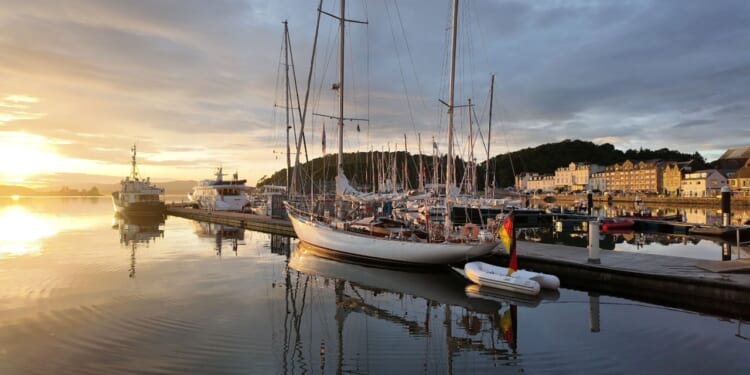More than a dozen navies around the world already employ tall sailing ships in order to train sailors in basic seamanship. The Royal Navy was not among them—until now.
It was during the “Age of Sail,” the era known for “wooden ships and iron men,” that the Royal Navy became the most powerful seagoing force in the world. After the Battle of Trafalgar in 1805, the British would not be seriously challenged at sea for a century and a half; its rule of the waves continued with the development of iron ships, including the modern battleship.
Yet today, there is no denying that the UK’s Royal Navy is a shell of its former self. Just as the United States military has opted to refocus on its “warfighting ethos” under Secretary of Defense Pete Hegseth, the Royal Navy has begun undertaking a return to the past by reviving a training routine not seen in more than a generation.
A series of trials was carried out aboard the Pelican of London, a British-flagged square-rigged sail training vessel resembling the Royal Navy vessels of old. Junior officers and sailors manned the ship as it sailed in the Irish Sea and Bristol Channel, making port visits to Liverpool, Dublin, and Belfast.
Making the Royal Navy Great Again
Following this first test voyage, the Royal Navy plans to charter a similar vessel for nine months in 2026, during which it will provide hundreds of officers and sailors with a more formal training course. The Royal Navy won’t be building Ships of the Line again; instead, the training is meant to allow sailors to focus on the basics, including navigation, watch-keeping, leadership, and teamwork in a working environment at sea.
According to the Royal Navy, the Pelican of London can typically carry “32 trainees and four instructors at a time,” and provides a more focused training setting that lacks the “distractions of a modern warship.” The Royal Navy is returning to its roots to strengthen core skills with a focus on teamwork.
“The modern Navy is very technical—we are not,” said Master Captain Roy Love of the tall ship. “There are few electronics. We are here to teach the basics of seamanship, what’s it like to live and work at sea, how to work together. It’s a steep learning curve for most, but the skills benefit anyone who sails with us.”
Pelican of London can also provide an introduction that allows sailors to get their sea legs.
“The ship offers a good introduction,” Sub Lieutenant Joel Crownshaw explained. “She makes approximately six knots, allowing a calm environment in which to consider situations and make measured decisions, building up confidence before you move on to larger and faster vessels.”
Many Modern Navies Continue to Operate Sailing Ships
The UK’s Royal Navy isn’t precisely charting new territory with this program. More than a dozen navies around the world already employ tall ships for sail training.
The US Navy doesn’t operate any large tall ships. Still, incoming cadets at the United States Naval Academy do participate in the Basic Sail Training (BTS) program. At the same time, midshipmen can join the Command & Seamanship Training Squadron to train on a sloop. The US Navy’s USS Constitution, a sailing ship, is the oldest commissioned warship in the world; it mostly functions as a museum ship, but technically remains in active service and occasionally sails on notable anniversaries.
The US Coast Guard also operates the USCGC Eagle (WIX-327), a 295-foot barque that Nazi Germany’s Kriegsmarine formerly used as the training ship SSS Horst Wessel. It was taken as war reparations after World War II.
Beyond the United States, tall ships have remained especially popular among the nations of Latin America, including Mexico. In one catastrophic incident, the Mexican Navy’s training tall ship ARM Cuauhtémoc ran into New York City’s famed Brooklyn Bridge during a port visit in May, killing two cadets and injuring 22 others. The training ship departed Acapulco, Mexico, in early April and was on a 254-day international tour that included port visits to New York and Aberdeen, Scotland, where it was intended to participate in the city’s Tall Ships race in July.
The Cuauhtémoc disaster served as a reminder that such training can still be especially hazardous. Yet, such ships still serve to promote the respective countries’ maritime history and seafaring heritage.
Given that nations such as France, Spain, and Italy already employ tall sailing ships, it is almost surprising that the UK has waited so long to re-implement this type of training.
About the Author: Peter Suciu
Peter Suciu has contributed over 3,200 published pieces to more than four dozen magazines and websites over a 30-year career in journalism. He regularly writes about military hardware, firearms history, cybersecurity, politics, and international affairs. Peter is also a contributing writer for Forbes and Clearance Jobs. He is based in Michigan. You can follow him on Twitter: @PeterSuciu. You can email the author: [email protected].
Image: Shutterstock / Susan Curley.

















